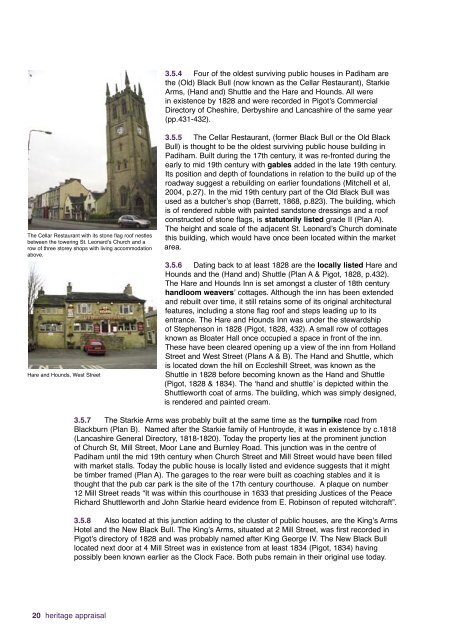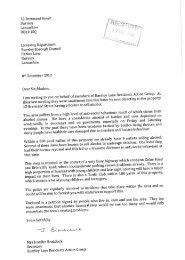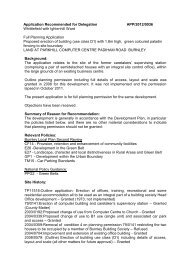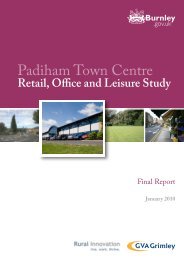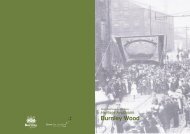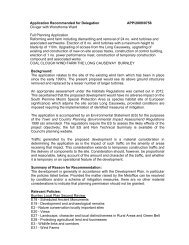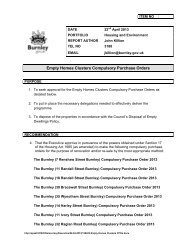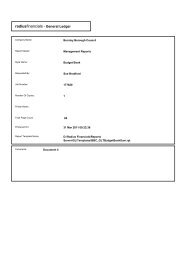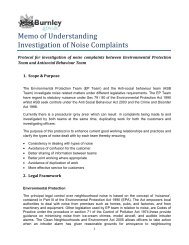3.5.4 Four of the oldest surviving public houses in <strong>Padiham</strong> arethe (Old) Black Bull (now known as the Cellar Restaurant), StarkieArms, (Hand and) Shuttle and the Hare and Hounds. All werein existence by 1828 and were recorded in Pigot’s CommercialDirectory of Cheshire, Derbyshire and Lancashire of the same year(pp.431-432).<strong>The</strong> Cellar Restaurant with its stone flag roof nestlesbetween the towering St. Leonard’s Church and arow of three storey shops with living accommodationabove.Hare and Hounds, West Street3.5.5 <strong>The</strong> Cellar Restaurant, (former Black Bull or the Old BlackBull) is thought to be the oldest surviving public house building in<strong>Padiham</strong>. Built during the 17th century, it was re-fronted during theearly to mid 19th century with gables added in the late 19th century.Its position and depth of foundations in relation to the build up of theroadway suggest a rebuilding on earlier foundations (Mitchell et al,2004, p.27). In the mid 19th century part of the Old Black Bull wasused as a butcher’s shop (Barrett, 1868, p.823). <strong>The</strong> building, whichis of rendered rubble with painted sandstone dressings and a roofconstructed of stone flags, is statutorily listed grade II (Plan A).<strong>The</strong> height and scale of the adjacent St. Leonard’s Church dominatethis building, which would have once been located within the marketarea.3.5.6 Dating back to at least 1828 are the locally listed Hare andHounds and the (Hand and) Shuttle (Plan A & Pigot, 1828, p.432).<strong>The</strong> Hare and Hounds Inn is set amongst a cluster of 18th centuryhandloom weavers’ cottages. Although the inn has been extendedand rebuilt over time, it still retains some of its original architecturalfeatures, including a stone flag roof and steps leading up to itsentrance. <strong>The</strong> Hare and Hounds Inn was under the stewardshipof Stephenson in 1828 (Pigot, 1828, 432). A small row of cottagesknown as Bloater Hall once occupied a space in front of the inn.<strong>The</strong>se have been cleared opening up a view of the inn from HollandStreet and West Street (Plans A & B). <strong>The</strong> Hand and Shuttle, whichis located down the hill on Eccleshill Street, was known as theShuttle in 1828 before becoming known as the Hand and Shuttle(Pigot, 1828 & 1834). <strong>The</strong> ‘hand and shuttle’ is depicted within theShuttleworth coat of arms. <strong>The</strong> building, which was simply designed,is rendered and painted cream.3.5.7 <strong>The</strong> Starkie Arms was probably built at the same time as the turnpike road fromBlackburn (Plan B). Named after the Starkie family of Huntroyde, it was in existence by c.1818(Lancashire General Directory, 1818-1820). Today the property lies at the prominent junctionof Church St, Mill Street, Moor Lane and <strong>Burnley</strong> Road. This junction was in the centre of<strong>Padiham</strong> until the mid 19th century when Church Street and Mill Street would have been filledwith market stalls. Today the public house is locally listed and evidence suggests that it mightbe timber framed (Plan A). <strong>The</strong> garages to the rear were built as coaching stables and it isthought that the pub car park is the site of the 17th century courthouse. A plaque on number12 Mill Street reads “It was within this courthouse in 1633 that presiding Justices of the PeaceRichard Shuttleworth and John Starkie heard evidence from E. Robinson of reputed witchcraft”.3.5.8 Also located at this junction adding to the cluster of public houses, are the King’s ArmsHotel and the New Black Bull. <strong>The</strong> King’s Arms, situated at 2 Mill Street, was first recorded inPigot’s directory of 1828 and was probably named after King George IV. <strong>The</strong> New Black Bulllocated next door at 4 Mill Street was in existence from at least 1834 (Pigot, 1834) havingpossibly been known earlier as the Clock Face. Both pubs remain in their original use today.20 heritage appraisal
3.5.9 <strong>The</strong> Dun Horse and the British Legion were also located onMill Street during the 19th century. <strong>The</strong> Dun Horse is likely to havebeen the Bay Horse, which was recorded in Pigot’s directory of1818-20. This building was once situated at number 18 Mill Street,but was cleared prior to 1919. Currently situated on this site is theformer Globe Cinema building, which is locally listed and occupiedby Conway Contractors (Plan A). Formerly located at 13 Mill Streetwas the British Legion (c.1827), a club for ex-servicemen. It laterbecame known as the Weavers’ Arms in c.1879 and the Cricketand Footballers’ Arms between c.1887-1890 (Barrett, 1890, 1887 &1879).3.5.10 <strong>The</strong> Free Gardeners’ Arms, located at the corner of BankStreet and St. Giles Street, was one of two beerhouses locatedon St. Giles Street during the 1800s. ‘<strong>The</strong> Free Gardeners Innwas named after the United Order of Free Gardeners. This was anational friendly society, which came into existence during the late18th century... <strong>The</strong> branch of Free Gardeners in <strong>Padiham</strong> formed in1827 and was known as Laurel Lodge’ (Glenn & WEA, 1986, p.71).<strong>The</strong> facade of the modern building dates from a slightly later periodthan the other buildings in the street but the site was used as abeerhouse in 1861. In 1933 the Free Gardeners’ was purchased byMassey’s Brewery of <strong>Burnley</strong> (WEA & Glenn, 1986, p.71).3.5.11 <strong>The</strong> second beerhouse known to have operated on St.Giles Street was the (Rifle) Volunteers. It possibly functioned asearly as 1834 (Pigot, 1834). ‘<strong>The</strong> inn took its name from the RifleVolunteer Corps, which formed on a countrywide basis from 1859after the Crimean War… <strong>The</strong> <strong>Padiham</strong> Corps was originally asubdivision of the <strong>Burnley</strong> Corps formed in 1860, and was knownas the 84th Lancashire Volunteers. <strong>The</strong>ir band was a familiar sightin <strong>Padiham</strong> in the 1870s and marched at the head of processions.’(Glenn & WEA, 1986, p.73). <strong>The</strong> Volunteers Inn was demolished in1956 as part of the PUDC clearance programme.3.5.12 <strong>The</strong> Alma Inn is a typical Victorian street corner pub,located at the junction of West Street and Alma Street. It hasassociations with the Crimean War and commemorates a battlefought at the River Alma in September 1854. <strong>The</strong> Alma Inn is notrecorded in the commercial directories until 1879 (Mannex, 1868,p.823 & Barrett, 1879, p.239). <strong>The</strong> entrances to the inn are locatedon both West Street and Alma Street today, but it is likely that theoriginal entrance, which has since been converted into a window,was found on the junction of the two roads.This interesting cluster of locally listed public housesis situated at the prominent junction of Mill Street,Moor Lane, <strong>Burnley</strong> Road and Church Street. Oncelocated within the original market place, the pubs laybeside the old toll road, which would have run alongChurch Street and into <strong>Burnley</strong> Road (Plans A & B).<strong>The</strong> Alma Inn situated on the junction of West Streetand Alma StreetFree Gardeners’ Arms, St Giles StreetThis Lancashire Library photograph illustrates theAlma Inn c.1920. Perhaps the woman in the pictureis the wife of Thomas Dickinson who ran the pub in1923 (Barrett, 1923, p.761).heritage appraisal 21
- Page 2 and 3: ‘Heritage is all around us. We li
- Page 4: oneintroduction1.1 Housing Market R
- Page 12 and 13: threecharacter area 13.1. Introduct
- Page 14 and 15: 3.2.9 On Whalley Road Epworth House
- Page 16 and 17: 3.2.19 Much of the cleared land in
- Page 18 and 19: Victoria Mill, Ightenhill Street.3.
- Page 20 and 21: This photograph shows John Paul Web
- Page 24 and 25: This Lancashire Library photograph
- Page 26 and 27: 3.6 Clubs and Community BuildingsFo
- Page 28 and 29: Former Wesley Chapel in West Street
- Page 30 and 31: 3.8.4 In 1814 ‘The British and Fo
- Page 32 and 33: 3.10. Landmarks, views, green space
- Page 34 and 35: fourcharacter area 24.1 introductio
- Page 36 and 37: Rendered property in the Garden Str
- Page 38 and 39: Fairweather Court/Town Hill BankFai
- Page 40 and 41: oneintroduction38 heritage appraisa
- Page 42 and 43: fivecharacter area 35.1 Introductio
- Page 44 and 45: Industrial Buildings5.3.8 The ‘Go
- Page 46 and 47: Alma MillToday British Velvets occu
- Page 48 and 49: 5.4. Housing5.4.1 Victorian neighbo
- Page 50 and 51: 7-23 Grove Lane. 21 Grove Lane appe
- Page 52 and 53: Number 46 Ingham Street was origina
- Page 54 and 55: sixcharacter area 46.1. Introductio
- Page 56 and 57: 6.2.7 Though disused, the line stil
- Page 58 and 59: 6.3. Housing6.3.1 Development began
- Page 60 and 61: Early residential area 1860-18906.3
- Page 62 and 63: Former shops within the wider stree
- Page 64 and 65: Architectural features and detailin
- Page 66 and 67: Looking up Burnley Road from the Br
- Page 68 and 69: 66 heritage appraisalCross Bank Day
- Page 70 and 71: 6.6. Landmarks, views, greenspaces
- Page 72 and 73:
sevencharacter area 57.1 Introducti
- Page 74 and 75:
7.3.6 Numbers 21-43 Green Lane, kno
- Page 76 and 77:
7.4 Late 20th century housing7.4.1
- Page 78:
Levant Mill7.5.7 Butterworth and Br
- Page 82 and 83:
Stockbridge Road: Barrett’s Direc
- Page 84 and 85:
7.9 Landmarks, views, green spaces
- Page 86 and 87:
eightcharacter area 68.1. Introduct
- Page 88 and 89:
Wakes Week, 1920s - a large crowd s
- Page 90 and 91:
8.2.12 In terms of its architecture
- Page 92 and 93:
1870s: Railway Road8.4.3 Building r
- Page 94 and 95:
1880s Whittaker Street8.4.9 Develop
- Page 96 and 97:
Post Office8.5.3 The Post Office, c
- Page 98 and 99:
ninecharacter area 79.1 introductio
- Page 100 and 101:
9.5 Landmarks, views, green spaces
- Page 102 and 103:
tenheritage and future regeneration
- Page 104 and 105:
appendixa-protected featuresA range
- Page 106 and 107:
appendixb-sourcesUnlike Burnley and
- Page 108 and 109:
Building Control RecordsBurnley Bor
- Page 110 and 111:
Handloom weaver Independent artisan
- Page 112:
Designed by Graphics, Burnley Counc


